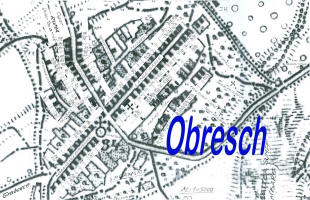Village of
Obresch
in Syrmia



|
1. German Evang. Bethaus 2. Serbian Church 3. Kneisel, Andreas 4. Geier, Georg 5. Back, Andreas
6. Fix, Johann
7. Schenk, Karl
8. Schenk, Philip
9. Siller
10. Siller,
Andreas
11. Sigmund, Jakob
12. Heinz, Karl
13. Heinz, Johann
14. Heinz, Johann
15. Bender, Adam
16. Staudt, Johann
17. Freund, Johann
18. Spä, Philip 19. Decker, Adam 20. Silberhorn, Jakob 21. Teachers Service house
22. Schenk’s Dairy
23. Dautermann,
Heinrich
24. Guesthouse
Staudt
25. Bogner,
26. Wagner,
Andreas
27. Arras, Franz
28. Sigmund,
Heinrich
29. Sigmund,
Daniel
30. Albert,
Mathais |
31. Altheim,
Andreas
32. Decker, Jakob
33. Kraus, Jakob
34. Holzmann,
Jakob
35. Holzmann,
Barbara
36. Meder, Jakob
37. Hügel, Franz
38. Fritz, Johann
39. Fritz, Johann
40. Damm, Michael
41. Damm, Michael
42. Greiling,
Anton
43. Meder, Georg
44. Meder, Georg
45. Leopold,
Nikolaus
46. Damm
47. Leopold,
Johann
48. Fischer
49. Albrecht, Adam 50. Leopold, Adam 51. Albert, Andreas 52. Kohl, Johann
53. Fritz, Georg
54. Kuhn, Jakob
55. Kohl, Eduard
56. Leopold, Adam
57. Heinz, Daniel
58. Müller, Johann
59. Dautermann,
Philip (Jr.)
60. Barth,
Heinrich |
61. Hügel, Michael
62. Leopold, Adam
63. Leopold,
Nikolaus
64. Kohl, Johann
65. Müller, Jakob
66. Decker,
Ferdinand
67. Fritz, Jakob
68. Scherer,
Ludwig
69. Wagner, Viktor
70. Wagner, Fritz
71. Klein, Peter
72. Hein
73. Heinz, Karl
74. Barth, Franz
75. Gleich, Jakob
76. Scherer, Georg
77. Heinz,
Heinrich
78. Heinz, Daniel
79. Lang, Johann
80. Lang, Karl
81. Federmann,
Franz
82. Bechtold,
Peter
83. Dautermann,
Philip
84. Staudt
85. Kohl, Jakob
86. Schön, Michael
87. Leopold,
Nikolaus
88. Hein, Georg
89. Hein
90. Hügel, Adam |
91. Hügel, Franz
92. Dautermann,
Philip
93. Leopold,
Heinrich
94. Hügel, Georg
95. Kraus, Martin
96. Strunk
97. Weitmann
98. Serbian
Priest’s house
99. Sigmund, Franz
100. German School
101. Serbian
School
102. Oster,
Andreas
103. Oster, Jakob
104. Oster, Jakob
105. Fix, Mathais
106. Oster, Karl
107. City Hall 109. Crown Prince Rudolf’s |
